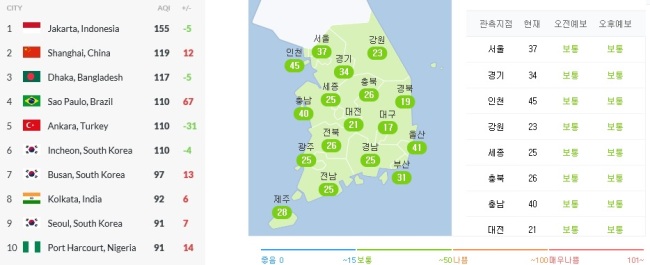South Korea is moving to raise standards for airborne pollutants to international levels, as part of its ongoing efforts to fight air pollution.

Currently, the country classifies air quality into four categories -- good, normal, bad and very bad -- based on a set of criteria, which includes daily average concentrations of PM 10 and PM 2.5.
PM 2.5 are ultrafine particles less than 2.5 micrometers in diameter that are classified by the World Health Organization as a first-degree carcinogen.
Up to 15 micrograms of PM 2.5 per cubic meter is considered “good”; 16 to 50 micrograms per cubic meter is “normal”; 51 to 100 micrograms per cubic meter is “bad”; and over 101 micrograms per cubic meter is “very bad.”
According to the Environment Ministry, the envisioned new scale, although details are yet to be finalized, would lower the bar for the “bad” level to 35 micrograms and above. This is still beyond the 25 micrograms that the WHO sees as an acceptable level of PM 2.5.
Last year, under the existing scale, South Korea had 15 “bad” air days based on the existing PM 2.5 standards, but the new standard would increase that to 44 days.
The changes, if they are implemented, will also increase the number of issuances of fine dust advisories and warnings.
On Tuesday, Seoul’s average PM 2.5 concentration was 37 micrograms per cubic meter, which would be classified a “normal” day under current standards, but “bad” according to the new one.
The ministry said it will complete discussions on the new standards for introduction as early as next year.
By Kim Da-sol (ddd@heraldcorp.com)





![[Herald Interview] 'Amid aging population, Korea to invite more young professionals from overseas'](http://res.heraldm.com/phpwas/restmb_idxmake.php?idx=644&simg=/content/image/2024/04/24/20240424050844_0.jpg&u=20240424200058)












![[KH Explains] Korean shipbuilding stocks rally: Real growth or bubble?](http://res.heraldm.com/phpwas/restmb_idxmake.php?idx=652&simg=/content/image/2024/04/25/20240425050656_0.jpg&u=)

